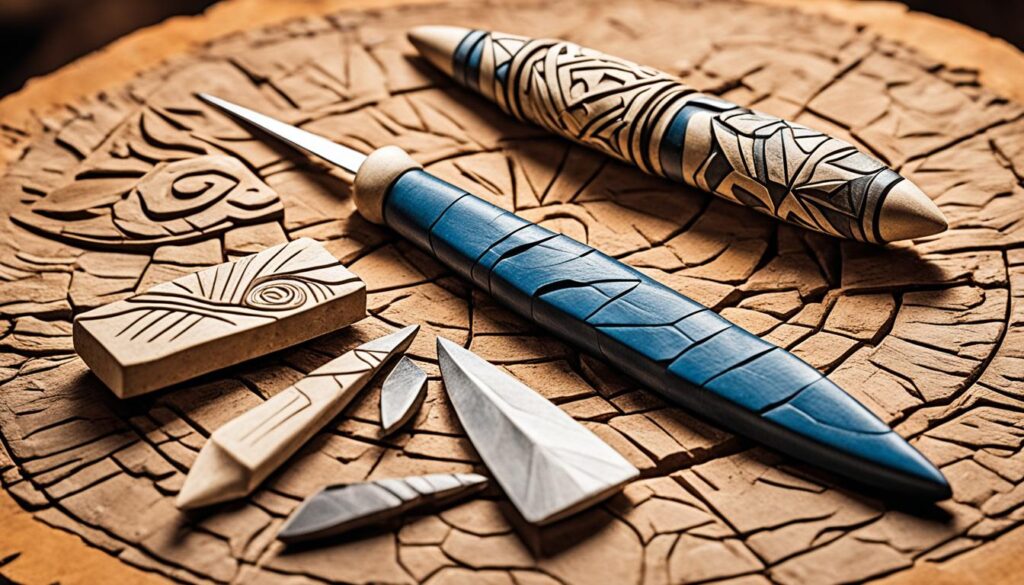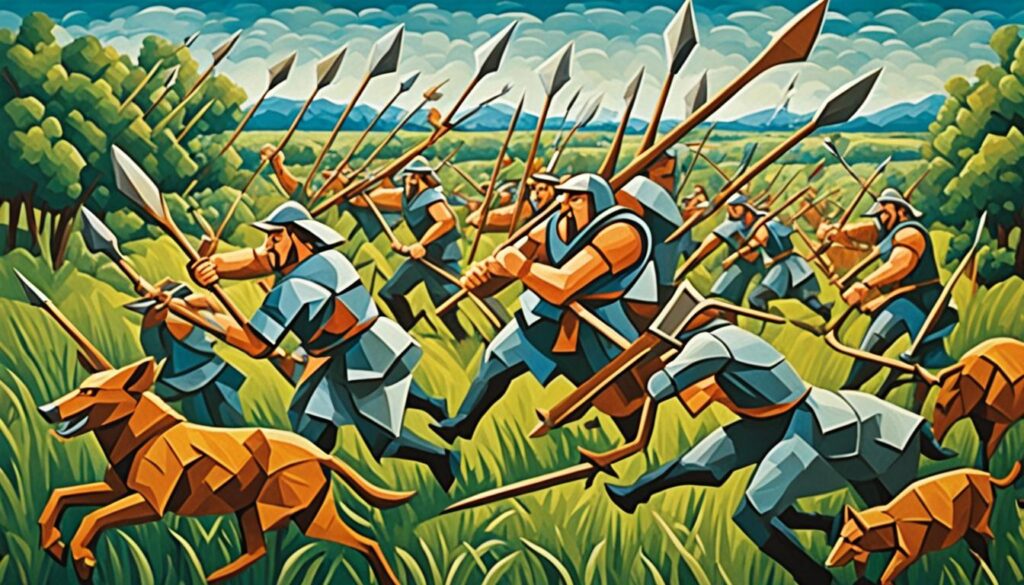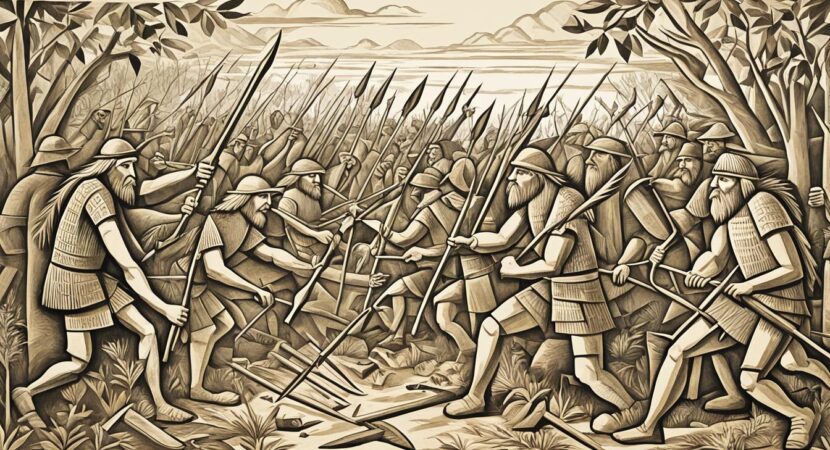The quest for survival has been a defining element in human evolution, and the development of prehistoric hunting weapons was pivotal in the ascendance of Homo sapiens. With each sharpened stone and crafted spear, early mankind embarked on a journey of innovation that would define their existence and firmly establish their place atop the food chain. The use of ancient hunting methods not only secured essential sustenance but also set in motion a wave of cognitive and collaborative developments that marked the path of our ancestors.
By delving into the artifacts and sites that pepper our planet, we’ve unearthed fascinating insights into the early human hunting techniques. Archaeological findings reveal a diverse arsenal wielded in the pursuit of prey, from simple hand axes to more sophisticated projectile points. Anthropological studies connect these tools to the complex lifeways of prehistoric hunter-gatherers, illuminating the myriad survival strategies they employed.
Contents
Key Takeaways
- The significance of hunting in human evolution cannot be overstated—shaping both our physical and social development.
- Early tools tell a story of ingenuity, marking humanity’s first forays into technology and problem-solving.
- Investigating the remnants of ancient weaponry offers us a glimpse into the resourcefulness and adaptability of early societies.
- Survival strategies prevailed in these formative times, spurred by the relentless pursuit of food and resource acquisition.
- Through the study of prehistoric evidence, we gain perspective on the diverse hunting methods that sustained human life millennia ago.
The Origin of Hunting: A Brief History
Shedding light on the history of hunting is akin to tracing the blueprints of human survival and advancement. The development of hunting skills was not a mere consequence of survival needs; rather, it was the cornerstone of early humans’ transition from passive foragers to active predators and critical thinkers. Our ancestral early hunter-gatherers shaped ecosystems and carved the path for civilized societies through the tools and strategies they created to hunt.
Hunting’s Inception
- Initially rooted in basic survival, the procurement of food was the first imperative that led to the formation of hunting practices.
- From opportunistic scavenging, early hominids rapidly evolved their capabilities to hunt, reflecting a significant milestone in hominin behavioral evolution.
Evolving Techniques
“The development of the hunt was a defining moment, where mankind grasped not only sticks and stones but also the concept of a planned approach.” – Paleoanthropological studies reveal.
- Communal strategies and the use of simple tools escalated into sophisticated ambush and pursuit strategies.
- The anthropology of hunting tells a complex tale of climate adaptation, inventive tools, and social learning.
- Stone tools and wooden spears were among the first instruments aiding in the kill.
- The shift from unsharpened stones to intricately-fashioned spear tips evidences the increasing complexity and refinement of hunting tools over millennia.
Hunting Skills and Society
- With the advent of hunting as a communal activity, the early hunter-gatherers honed not just solitary skills but also collaborative tactics that strengthened social bonds and community structure.
- The division of labor during cooperative hunts possibly laid the groundwork for complex human society hierarchies.
As we comb through the skeins of the past, we encounter irrefutable proof of the substantial impact of hunting on human history. Each advancement, from tool-making to strategic hunting formations, echoes the ceaseless human quest for knowledge and mastery over one’s environment. The history of hunting is not merely about survival—it is the story of humanity’s quest to understand, adapt, and ultimately thrive in a world fraught with challenges and ripe with opportunities.
| Timeline | Tool Development | Hunting Strategies |
|---|---|---|
| 2.6 Million Years Ago | Oldowan pebble tools | Scavenging and opportunistic hunting |
| 500,000 Years Ago | Hand axes and cleavers | Large game hunting and drives |
| 400,000 Years Ago | Wooden spears | Ambush strategies |
| 20,000 Years Ago | Bone and antler projectiles | Collective hunts and advanced trapping |
Understanding the Role of Hunting in Early Human Societies

The intrinsic value of hunting within early human societies extends well beyond the basic act of acquiring food. It represents a complex tapestry of survival strategies, societal development, and cognitive evolution that signifies the journey of Homo sapiens from primal beings to structured societies. Examining the multi-faceted roles of sustenance hunting offers profound insights into the evolution of human societies.
Securing Food and Survival
In the era where survival hinged upon the day’s catch, the practice of hunting was not a choice but a necessity. Sustenance hunting was the bedrock upon which our forebears built their daily existence. Anthropological findings suggest that owing to hunting, early humans were able to secure a consistent and nutrient-rich food source, vital for their survival and growth.
Social Dynamics and Hunting Practices
The hunter-gatherers’ society was not a mere cluster of individuals; it was an organized system where hunting formed the basis of social structure and dynamics. Skilled hunters often assumed leadership roles, guiding the group and passing on knowledge. This division of labor based on hunting prowess reinforced bonds and shaped the very fabric of early communities.
Evolutionary Impact of Hunting on Homo Sapiens
Hunting did more than fill hungry stomachs—it catalyzed the cognitive and physical development of our ancestors. Research indicates that the strategic complexities involved in hunting led to advances in problem-solving abilities, communication, and even the development of tools. The transformation from simple survivalists to complex hunter-gatherers’ societies marked a pivotal chapter in the human evolutionary narrative.
| Societal Aspect | Impact of Hunting | Evidenced Evolutionary Changes |
|---|---|---|
| Nutrition | Diversification of diet, improved health | Development of larger brains, robust bodies |
| Technology | Advancement in tool-making | Enhanced dexterity, problem-solving skills |
| Community Structure | Establishment of roles, leadership | Sophisticated social interactions, stronger group cohesion |
The story of early human subsistence through hunting is one of tenacity and ingenuity, illuminating the profound ways in which this practice has structured societies and propelled the species forward. The legacy of the hunter-gatherer period can be seen in our continued inventive spirit and the collaborative underpinnings of modern civilization.
Examining the Early Hunter’s Arsenal: Hunting Tools Used by Early Man
The adaptive strategies and resourcefulness of early man are perhaps best illustrated through their development of hunting tools. These tools, crafted with skill and forethought, played a crucial role in the survival and evolution of human societies. From the crafting of prehistoric spears to the precision of early archery tools, and the cunning deployment of traditional hunting traps, early humans demonstrated a remarkable understanding of their environment and the behavior of their prey.
Stone-Tipped Spears: From Simple to Complex
The spear, a quintessential symbol of prehistoric weaponry, began as a simple sharpened wood shaft but evolved over time to become a sophisticated weapon. Archaeological excavations have unearthed spear points made from flint, obsidian, and even bone, highlighting a trajectory of innovation in prehistoric spears. These ranged from basic hand-thrown javelins to complex atlatl dart-throwing systems, which enabled hunters to engage their prey at greater distances and with improved accuracy.
Bows and Arrows: Precision Distance Weapons
The bow and arrow represented a significant leap in hunting technology. Considered one of the earliest archery tools, the bow allowed hunters to strike from a distance, thus reducing the risk of injury from larger prey. Technological analysis indicates that early bows were made from a variety of materials, including wood, horn, and sinew, illustrating the ingenuity of past societies in utilizing available resources to enhance their hunting capabilities.
Snares and Traps: The Art of Stealth
While spears and bows may have dominated the narrative of prehistoric hunting, it was the use of snares and traps that exemplified the element of stealth. Cultural studies suggest that early hunters were adept in setting up traditional hunting traps, such as pitfall traps, deadfalls, and snares, to capture game. These passive hunting techniques allowed them to catch prey without being physically present, displaying their understanding of animal behavior and habitat.
Together, these hunting implements—physical extensions of early human wit and will—paint a picture of a species determined to not only endure but also to master their environment. The examination of these tools goes beyond mere the physical remnants; it represents a deep dive into the lives and minds of people who walked the earth thousands of years before us, providing invaluable insights into human innovation and adaptability.
Tech Craftsmanship: Making and Maintaining Early Hunting Tools

The invention and refinement of tool-making techniques played a fundamental role in the narrative of human evolution. From sharpened rocks to carefully shaped spear points, early human craftsmanship was an essential element in the story of survival. Lifetimes of observation and experimentation empowered our predecessors to shape raw materials into survival technologies that would ensure their success in the harsh landscapes they inhabited.
Investigating the primitive tool-making methods through rigorous research, we unveil the sophisticated knowledge our ancestors utilized. Crafting tools required a deep understanding of the properties of various natural resources such as stone, wood, bone, and sinew. These resources were selected carefully based on their quality and functionality for specific hunting tasks.
Experimental archaeology offers us tangible insights, recreating ancient tools, and thereby providing a window into the past. Mimicking the ages-old practices, modern craftsmen have rediscovered the meticulous processes involved in creating these implements, from selecting the ideal flint nodule to the precision striking technique needed to flake off a serviceable tool.
Further exploration through the analysis of wear patterns on ancient tool remnants has shed light on how these tools were not only made but also maintained. The edge-wear patterns indicate regular resharpening and repairing, showcasing an intimate relationship between tool and maker. This relationship underscores a culture of sustainment, conservation, and respect for the tools that secured our survival.
- The selection of materials was based on factors such as availability, durability, and workability.
- Understanding the fracture mechanics of stone played a pivotal role in creating sharp-edged tools.
- Wood working required expert knowledge of growth patterns and seasonal cycles for material harvesting.
- Bone and antler, while less common, were fashioned into tools and ornaments with symbolic and utilitarian values.
The technology passed from one generation to the next, signifying a tradition of knowledge transfer that has continued to evolve into the present day. These tool-making techniques and maintenance practices are evident in the sophistication of early weapons uncovered from archaeological sites around the world and play a critical role in our understanding of early human craftsmanship and ingenuity.
The Cultural and Ritual Importance of Hunting Implements

The intricate tapestry of early human civilizations is incomplete without acknowledging the profound significance their hunting implements held in daily life. These items transcended functionality, embedding themselves deeply into the realms of spirituality and society. Enshrined as cultural artifacts, they held sway over the collective psyche, permeating through hunting rituals and ancestral hunting traditions.
Totems of Survival: Significance in Early Societies
Hunting tools were potent symbols, emblems of prowess and survival. They became integral to cultural identity, often embodying the attributes of the animals they were used to hunt. As societies evolved, these tools were revered and sometimes even worshipped as totems, bridging the gap between the physical and the spiritual, binding communities with a shared reverence for the instruments of their subsistence.
Ceremonies and Hunting: Blessings for Success
Pre-hunt ceremonies were core to many ancestral communities, steeped in the belief that these rituals would curry favor with spiritual realms, guaranteeing a bountiful hunt. Ethnographic records detail vivid narrations of dances, chants, and rituals: acts of communion with nature’s spirits and deities, pleading for a hunt that would sustain and nourish the tribe. Such hunting rituals served as a fulcrum around which the spiritual and practical needs of early humans revolved.
Passing Down Traditions: Heirlooms and Education
Our ancestors’ legacy is often embodied in the meticulously crafted hunting implements they’ve left behind. These pieces, beyond their immediate utility, were passed down as heirlooms, carrying with them stories, skills, and life lessons. Each generation ingrained in the next the values and techniques of their hunting traditions, ensuring the continuity of their culture’s survival strategies and respect for the natural world.
The intricate designs and decorations often found on hunting tools signal their value beyond the hunt. Cultural artifacts uncovered by archaeologists reveal that intricate carvings and adornments were common, suggesting a significant investment of time and, thus, a deeper cultural importance.
| Hunting Implement | Symbolic Meaning | Role in Rituals |
|---|---|---|
| Decorated Spears | Power and precision | Used in pre-hunt ceremonies |
| Carved Bow | Grace and distance | Blessing of arrows for success |
| Ornamented Knives | Vitality and strength | Passed down as symbols of heritage |
In the annals of time, these enduring practices, rituals, and the veneration of hunting tools serve as testament to the rich and complex lives of the people who once wielded them. Immersing ourselves in the study of these cultural artifacts, we gain a profound appreciation for the sustainable, connected, and reverent approaches our forebears had to the natural world and the earnest respect for the means that allowed their survival.
Conclusion
The journey through the prehistoric landscapes of our ancestors ends with a profound recognition of the significance of early hunting. The formidable legacy of ancient hunters is evident in their brilliant survival technologies—the artifacts and remnants of which form core chapters in the human story. As we have traveled back in time, exploring the evolution of hunting tools, we’ve uncovered more than simple devices for subsistence; we’ve discovered the milestones marking the progress of human intelligence and adaptability.
In the grand tapestry of human history, the ability to hunt effectively was perhaps among the foremost drivers that propelled our species forward. The ingenuity and versatility manifested in the range of ancient weaponry highlight an enduring human trait—our capacity to confront and surmount the challenges of our environment. From the humble beginnings of sharp rocks and sticks to elaborate traps and bows, these implements not just serve as historical curiosities; they are testaments to the innovative spirit that has and continues to define our species.
Reflecting upon the past has indeed illuminated our present understanding. The legacy of ancient hunters has transcended time, informing our modern sensibilities and practices. These early technological advancements set forth the momentum for future progress, underscoring the indisputable connection between our survival skills and the blossoming of civilizations. As we pivot our gaze from yesteryears’ achievements to today’s modern marvels, we cannot help but stand in awe of the enduring, indomitable human spirit, which first sparked to life around ancient campfires and still burns fiercely in the hearts of contemporary creators and innovators.


Reply